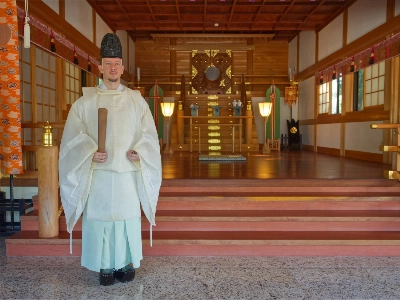* Japanese name: Hizara-gai
* Scientific name: Acanthopleura japonica
* Description: Chitons are mollusks, not bivalves like mussels, but single-shelled animals like limpets. To the casual observer, though, these creatures, which grow to about 4-cm long, might not be noticed, as they blend in extremely well with the rocks and clumps of marine plants growing on the seashore. They are, however, easily identifiable by the eight calcareous plates on their back. The plates, which form a "shell," are embedded in a strong muscular "foot" or mantle, which they use to cling strongly to the rocks, and which they can also use to creep slowly around. A frizzy edge can be seen protruding from the calcareous plates -- this is the top of the foot. The gills, used to extract oxygen from the sea water, may also be seen hanging out at the posterior end of the animal. The Japanese name hizara means "pipe bowl" or "fire bowl," and seems to refer to the fuzzy protruding edge of the mantle -- presumably because it looks a bit like tobacco in a pipe.
* Where to find them: On the seashore, plastered to rocks, all over Japan, from Hokkaido to Okinawa.
* Food: Algae. It might not look like much, but the chiton is often one of the dominant herbivores on rocky shores in East Asia. Although they only graze on algae, they have tough mouth parts, and tiny particles of coral and stone break off as the chitons scrape away at the algae. The scraping organ is called a radula, which is a type of tongue carrying several rows of tough little teeth. The scraping action can contribute to the erosion of coral islands in tropical and subtropical parts of the world. The teeth are covered in a layer of magnetite, a hard mineral containing iron. Some species are carnivorous, craftily raising their body from the rock and then clamping down on small crustaceans or even small fish that swim underneath for shelter.
* Special features: The protective plates of the chiton are made of a carbonate mineral called aragonite. These animals don't always move slowly. If a chiton is attacked it can roll into a ball like a hedgehog, and the eight plates allow the animal the flexibility to cling tightly to irregularly shaped surfaces. Chitons have many predators so need to be able to hang on to rocks and rely on their aragonite shell. Predators include gulls, starfish, crabs, fish and sea anemones. The flexibility also allows it to squeeze into small cracks, into which hard-shelled mollusks can't fit, to escape from the sun when the tide is out. PHOTO COURTESY OF BIO-IMAGE NET
9 mins ago



















With your current subscription plan you can comment on stories. However, before writing your first comment, please create a display name in the Profile section of your subscriber account page.